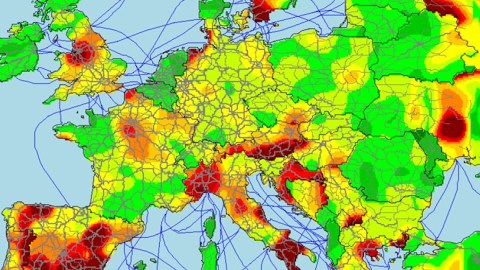Thumbs up? Map shows Europe’s hitchhiking landscape

Image: Abel Suyok
- A popular means of transportation from the 1920s to the 1980s, hitchhiking has since fallen in disrepute.
- However, as this map shows, thumbing a ride still occupies a thriving niche – if at great geographic variance.
- In some countries and areas, you’ll be off the street in no time. In other places, it’s much harder to thumb your way from A to B.

User-based tips and tricks on how to hitch a ride throughout Europe (and the rest of the world).
Image: Hitchwiki
Rated for hitchability
If you’ve never stuck out your thumb to get somewhere, nor picked up someone who did, you’re now part of the overwhelming majority. Nevertheless, like vinyl, hitchhiking has survived the predictions of its demise and occupies a small but thriving niche.
There’s an entire wiki dedicated to the practice, including a map detailing hitchhiking spots around the world, rating each for ‘hitchability’ and providing a user-generated average waiting time for each spot.
Based on that information, Abel Sulyok has produced this map, showing average waiting times across Europe as experienced by hitchhikers themselves. The map provides a curious overview of the continent’s hitchhiking landscape, indicating where it’s easier to hitch a ride, and where your thumb is going to be sore before you’re picked up.

Hitchhiking success (or failure) doesn’t just depend on your technique or appearance, also on your location.
Image: Abel Sulyok
Hitchhiking heat map
In areas colored darkest green, you’re off the street in 10 minutes or less. Lightest green: half an hour. Things turn yellowy in areas where you have to wait up to an hour and then change to red for times up to 90 minutes. If it’s more, you’re in a deep burgundy.
A few observations:
- Some countries seem more hitchhiker-friendly than others. According to this map, you’ll have most luck sticking out your thumb in Ireland, the Netherlands, Belgium, Denmark, Albania and Romania – all mainly light green.
- In-between countries include the UK, France, Germany, Poland, Bulgaria, Macedonia and Turkey (among others).
- Worst countries to hitchhike, at least according to this map: Spain, Portugal, Italy, Croatia, Greece, Austria, Sweden.
And, more specifically:
- Border areas seem prone to hitchhiking problems, although curiously often just in one direction. Check the Russian-Belarus border, or the ones between Bosnia and Serbia, Greece and Turkey, or Austria and all points south.
- Urban rides can be more difficult to hitch; see the ‘hot spots’ covering Paris, Athens, Kiev and the Liverpool/Manchester area in northwest England. In big cities, motorists can always soothe their bad conscience thinking the next car will pick up that rain-soaked stranger.
- Red can also mean remote, as it certainly does in Scotland’s furthest north, or the interior of northern Sweden and Norway.
- Other red zones are more difficult to explain. Why the generalized aversion to autostopistas in both southern Spain and southern Italy? Why is Germany’s Frisian coast so atypically hostile to hitchhikers? And what makes the southern Swedes so unamenable to helping out their non-motorized fellow travelers?
As this map shows, your hitchhiking success depends not just on your presentability, but also on where you present yourself.

A young Ernest Hemingway (17 in 1916), freighthopping to get to Walloon Lake.
Image: Wikimedia Commons / Public Domain
From freighthopping to hitchhiking
Hitchhiking has a long tradition in the U.S. Its direct ancestor was freighthopping. After the Civil War, if you were looking for work but without your own means of transportation, you’d hop on freight trains to travel long distances.
By 1911, the ranks of these hobos (1) had swelled to an estimated 700,000 – or about 0.75% of the entire U.S. population at the time.
While lots of people kept riding the rails throughout the 20th century (2), the rise of the automobile provided a much safer and more flexible means of hitching rides to faraway destinations.
Popular (and patriotic)
Hitchhiking (3) really took off after 1929, when the Depression both limited people’s options to buy their own cars and increased their need to move around to find work. Under the New Deal, the US Government even set up a Transient Bureau that helped both hobos and hitchhikers.
Hitchhiking entered the national consciousness, portrayed in popular books (John Steinbeck’s The Grapes of Wrath) and films (It Happened One Night, starring Clark Gable and Claudette Colbert).
By one estimate in 1937, at least one adult American male in 10 had hitched a ride at least once. A Gallup poll conducted during World War II, when fuel-rationing and car shortages were keeping hitching popular (and patriotic), indicated that nearly half of all Americans had picked up a hitchhiker.

Two FBI posters, signed by America’s anti-hitchhiker-in-chief, J. Edgar Hoover.
Image: FBI / Public Domain
Friendly traveler or vicious murderer?
However, there were problems with hitchhiking almost from the start. Early on, public opinion swung against aggressive hitchhikers, sometimes standing in the middle of the road, practically “demanding a ride”. Reports of crimes – real or otherwise – committed by hitchhikers predisposed the public and the authorities against it.
After WWII, laws and law enforcement further discouraged the practice, as exemplified by these FBI posters, warning drivers against hitchhikers: They could be “a happy vacationer or an escaping criminal – a pleasant companion or a sex maniac – a friendly traveller or a vicious murderer.”
In the 1970s and 1980s, a slew of highly publicized crimes involving hitchhikers (to name just one: the Santa Rosa Hitchhiker Murders, 1972-73) – and a few movies playing on the fears they generated (The Texas Chainsaw Massacre, 1974; The Hitcher, 1987) – helped end its heyday.

The Interstate Highway System in 1976
Image: U.S. Department of Transportation / Public Domain
Unsuited to hitchhiking
Add to that the generalized sentiment nowadays that ‘stranger’ equals ‘danger’, and the demise of hitchhiking seems logical. From the 1920s right up to the 1980s, thumbing a ride was a fairly common way to get around. These days, it’s the option of last resort.
But perhaps the main reasons for hitchhiking’s decline have less to do with moral panic, more with fundamental changes in infrastructure. For one, there’s the post-war rise of the Interstate Highway System: Bigger, faster roads that are unsuited to hitchhiking.
The biggest underlying factor may be the rise of car ownership. The percentage of US households without a car has steadily declined, from about 50% in 1941 to less than 10% today (4). If you have a car, you don’t need to hitch a ride.
This map was produced by Abel Sulyok, based on data from Hitchwiki. Image found here on Reddit. Reproduced with Mr Suyok’s kind permission. Many thanks to Katrien Luyten for pointing it out. It would be interesting to see a North American version.
For more on hitchhiking’s decline, check this great article by Dave Margulius, first published in the Washington City Paper in 1988.
Considering all the scare stories, hitchhiking is much safer than you’d think. Nevertheless, if you’re considering thumbing your way across the world, read up on some practical and safety tips first.
Got a strange map? Let me know at strangemaps@gmail.com.
(1) A short dictionary of early 20th-century vagrancy. Hobo: someone traveling to look for work. (Term possibly derived from hoe-boy, i.e. ‘farmhand’, or an abbreviation of homeward bound). Tramp: someone traveling, but not looking for work. (From tramping, i.e. long-distance walking, as this was their main means of getting about). Bum: someone neither looking for work nor traveling. (From the German bummler, ‘loafer’).
(2) There are still enough hobos around to animate a National Hobo Convention, every August since 1900, in Britt, Iowa. Nevertheless, the lifestyle is definitely fading – see this article about The Last Great American Hobos.
(3) Curiously, the term is much older than the automobile. It describes the practice of ‘horse-sharing’ in the Old West. According to an article in the American Motorist in 1978, “One man would start walking while the second man rode the horse to a predetermined spot. He would hitch the horse to a tree and walk on. When the first man [arrived], he would take the horse and ride past the other man to another predetermined spot.”
(4) In 2010, 91.1% of American households had at least one car. In 2015, that figure had dropped slightly to 90.9%. Trendwatchers attribute this first decline in decades to millennials in big cities preferring car ‘usership’ over car ownership. However, the U.S. Census figure for 2017 indicates car ownership has gone up again, to a record 91.2%.





